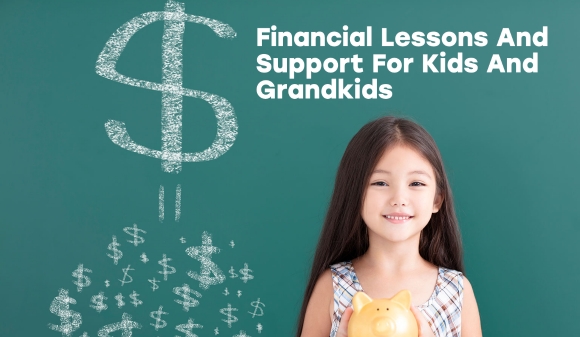Financial Lessons And Support For Kids And Grandkids

 Parents and grandparents provide direct and indirect financial support for their children and grandchildren. They are influential in shaping a child’s money mindset based on early lessons and ongoing behaviour.
Parents and grandparents provide direct and indirect financial support for their children and grandchildren. They are influential in shaping a child’s money mindset based on early lessons and ongoing behaviour.
As a child or grandchild ages, there are different ways to support them financially and to teach them about money matters.
Toddlers
Research from the U.K. government conducted by David Whitebread and Sue Bingham of the University of Cambridge looked at how children learn and develop their personal financial knowledge. “Habit Formation and Learning in Young Children” found that many money habits are established by the age of seven. Parenting practices and styles were found to have the biggest impact, but teachers, peers, the media, and advertising also influence how children learn and develop financial understanding.
The research found that trying to literally teach children about money may be ineffective at too young an age. Instead, the more successful approach was found to be teaching things like delayed gratification and the concept of planning for the future. “It is the basic approaches and skills which are modelled, discussed, and demonstrated by parents and other significant adults that are likely to be influential ‘levers’, instilling efficient habits and practices.”
A Registered Education Savings Plan (RESP) is likely the best financial tool to help a young child or grandchild save for a cost the majority will incur—post-secondary education. Deposits of up to $2,500 per year for a beneficiary attract a 20 per cent government Canada Education Savings Grant (CESG). Additional federal or provincial grants may be available for low-income families.
RESP accounts grow on a tax-deferred basis with principal withdrawn tax-free and eligible withdrawals of income and grants being taxable to the beneficiary at what is generally little to no tax payable. RESPs can be used for funding university, college, trade school, and other eligible post-secondary programs.
Pre-Teens
Most pre-teens have a phone or other mobile device, and as social media usage increases among younger users, children’s impressions of wealth and success are highly impacted by uncensored influencers.
This makes it that much more important that parents are modelling delayed gratification and other good money habits for their kids. Several provinces have introduced personal finance education for school age children, including Ontario’s new math curriculum with mandatory financial literacy concepts taught as early as the first grade.
Pre-teens should have a bank account for gifts or an allowance to start to understand the concept of saving and spending. Informal trust accounts may be an option for purchasing stocks, bonds, mutual funds, or Exchange-Traded Funds, but RESPs are generally superior investment account alternatives to taxable non-registered accounts that do not benefit from government grants.
Teenagers
Most children get their first job as a teenager. The minimum legal working age varies across Canada and typically ranges from 12 to 14 years of age. Some provinces and territories have no minimum, but prohibit dangerous work, working during certain hours, or require written permission from a parent for a child to work.
Children need a Social Insurance Number and bank account to be paid hourly wages, and that means they can file a tax return. There is a federal basic personal amount of $13,808 for 2021, and provincial and territorial basic personal amounts that range from $8,481 in Nova Scotia to $19,369 in Alberta. Taxable income below these exemptions is generally tax-free, so many parents forego filing tax returns for young people.
However, some of the tax withheld may be eligible for a refund and filing a tax return may entitle a child to federal or provincial benefits. Filing a tax return to report employment income also generates Registered Retirement Savings Plan (RRSP) room. Unlike a Tax-Free Savings Account (TFSA), there is no minimum age for opening and contributing to a RRSP.
Filing a tax return also helps teens further develop their understanding of money and taxation.
Saving goals like a car or post-secondary education provide tangible life events to teach a child about short and long-term budgeting. Many parents do not know how much college or university costs, let alone do their teenage kids, so getting a sense of future post-secondary expenses may be helpful for parents and children alike.
20s
The age of majority is 18 in six provinces and 19 in the remaining provinces and territories, and this is the age at which a child can get a credit card. If they do not have a credit card by their 20s, they should probably get one for the sole purpose of building a credit score since the length of your credit history helps increase the score.
If a child has not already incurred debt for school or a car by their 20s, it will not be long before they do, so getting used to credit concepts is an important learning experience. As a parent, remember if you co-sign for a credit card or other debt for your child, you can be held responsible for outstanding balances. Late payments may impact your own credit score.
The minimum age to open a TFSA is age 18. Young adults should be encouraged to open TFSA accounts even if their savings are modest and simply held in a savings account. TFSA withdrawals can be used for any purposes, including funding future RRSP contributions as a child’s income rises. Parents who can afford to do so can even give their child money to contribute to a TFSA without tax consequences or impacting their own TFSA room. This can be a strategy to help save for post-secondary costs, a car, a home down payment, or a wedding that a parent intends to contribute to for that child.
One saving strategy a parent can use is to replicate the nudge theory tactics used by employers and governments to encourage saving. You may not be able to force a 20-something to save, but you could, for example, commit to matching their contributions. Maybe you offer to match up to $500 of contributions to a TFSA or RRSP account each January based on their contributions for the previous year.
30s
Children in their 30s become more financially independent as they establish their careers. That does not mean there are not opportunities or even what may seem like requirements to help them financially.
A child may need a co-signor on a mortgage to buy a home, especially in some of Canada’s more expensive cities. Co-signing has a lot of implications. As mentioned previously, late payments may impact a parent’s credit rating and non-payment can result in an obligation for that co-signor to take over a debt.
Co-signing for a mortgage may also impact land transfer tax rebates for first time homebuyers, capital gains tax payable on a principal residence, or the division of assets in the event of a divorce of one of the borrowers.
If you lend money to an adult child, especially if they are in a relationship, you may want to document that loan formally with a promissory note or demand loan. Money loaned to purchase a home can be secured as a second mortgage by a real estate lawyer.
There are some unique ways to help a child indirectly without just giving them money. One is to purchase insurance for them. Life insurance tends to be relatively inexpensive for a young person because the likelihood of them dying is relatively low. Living benefits insurance like disability or critical illness insurance tends to be more expensive given a disability or illness is more likely to happen to a young person than for them to die. The payout, especially for disability insurance, can also be much higher. A young person disabled at 35 may receive up to 30 years of monthly disability payments until they are 65 years old, for example. This could amount to millions of dollars.
Not only are living benefits premiums generally more expensive than life insurance for a young person, but they are also less likely to have coverage as well. Many employers offer life insurance but no living benefits coverage. Furthermore, if a young person with no dependents dies, they may not even need life insurance. If they become disabled or experience a critical illness, they are still alive, still have costs to cover, and may even have higher monthly costs than when they were healthy.
If a parent pays for $1,000 of premiums for disability or critical illness insurance for a child, it can be a way to ensure they are protected. If a parent gifts $1,000 to a child, it is much less likely they will go get a living benefits insurance policy over using that money for something else.
Grandparents can open an RESP account for a grandchild that is owned by them, or alternatively, contribute to an RESP account that is owned by their children for their grandchildren. Funding RESP contributions for a grandchild can be a way to indirectly help your children, who do not need to worry about contributing as much themselves. It also helps ensure funds are there for your grandchildren to pursue post-secondary education in the future.
There are different ways to teach your children good money habits or to help them financially. The opportunities to build a healthy money mindset start younger than most parents would otherwise think. Modelling good financial behaviour yourself is probably the best way to prepare your kids for a successful financial future. But there are also indirect and direct ways to do so that may change over your life and that of your children and eventually their children.
Jason Heath is a fee-only, advice-only Certified Financial Planner (CFP) at Objective Financial Partners Inc. in Toronto, Ontario. He does not sell any financial products whatsoever.

